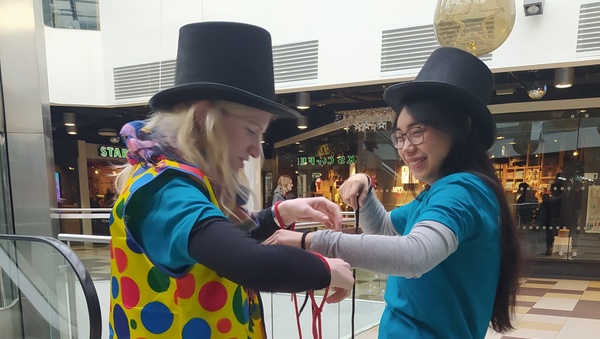Creative Careers Week 2022

Creative Careers Week
This week is Creative Careers Week (21 - 25 November) where you can find out about different jobs and routes in the arts sector. Maths and creativity may not seem to go hand in hand but there's plenty of maths in the creative and cultural sector, and plenty of creativity in maths!
Creative Careers Week showcases creative and cultural industries and highlights the breadth of roles and range of pathways available. It is also a chance for employers to challenge misconceptions about what a job in creative and cultural sector is and involves! If you are an employer in the industry sign up to take part, and download the toolkits and resources for employers and educators.
Over the last few years we've collaborated with cultural and creative organisations showing that maths and creativity can go together and plenty of jobs require both! We've shared a few of those below.
Curtain Up
During Maths Week Scotland people shared the maths they use every day in their jobs and workplaces. Over at Theatre Royal in Glasgow pupils from Eastbank Academy and Eastbank Primary School got a chance to head behind the scenes hosted by Creative Learning, King's Theatre & Theatre Royal, Scottish Opera, and award-winning architects Page/Park, designers of the new foyer at the Theatre Royal.
The day focused on the skills and professions that blends arts and science, seeing examples of how maths is applied in backstage and technical roles including a backstage tour.
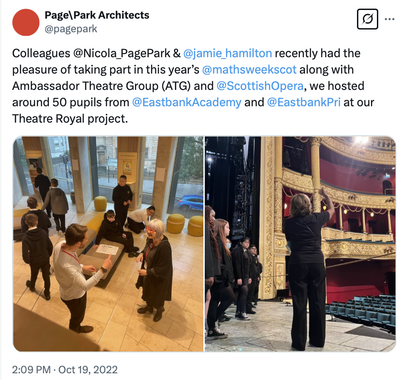
Pupils also turned their mathematical and creative eyes to the architecture of the building and the impressive double helix staircase. They were challenged to create their own design for the staircase with winners receiving tickets to see Beauty and the Beast.
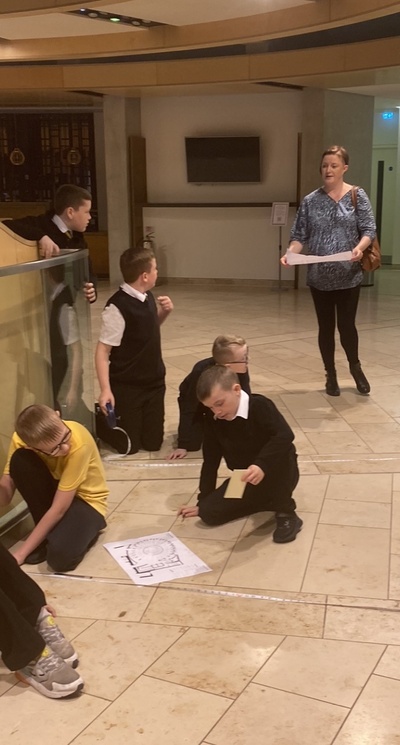
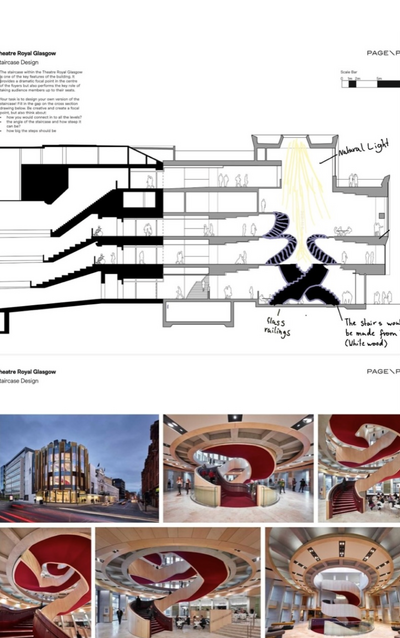
“The S1 pupils were full of praise when they got back to school. It was a great experience for pupils that have recently joined Eastbank to find out more about ATG, the job roles available in this sector and to challenge themselves putting Maths into real life situations. Lovely for them to be out in the real work after the last few years of education disrupted by Covid”
Developing the Young Workforce School Co-ordinator, Eastbank Academy
Putting on a Show
There are all sorts of jobs behind the scenes of a big production - both indoors and outdoors! Back in 2020 we spoke to Kate Bonney, a lighting designer all about the maths in her creative career.
What do you love about your job?
I love being a small part of a bigger team. I love making an audience feel something and seeing an audience reacting in the way that we hoped. It is fantastic when we make people happy, react to a spectacle we created or draw attention to stories that people need to hear.
How does my work impact others?
My work is entirely about impacting the audience. Sometimes that is about making people have a really good night out, other times it is about creating an atmosphere that is scary as part of a theatre production. Sometimes it just about trying to tell people about what time of day it is, such as morning sunlight shining through a window.
What is one thing people assume about your job that isn’t true?
Biggest thing people assume about my job is that it is glamorous. It isn’t glamorous! When we are working outdoors we have to work when it is dark so we often have to work overnight in the rain and cold. When we are working in theatres it is dusty and we have to spend a lot of time up ladders. Not glamorous at all....
What originally got me interested in maths?
Truth be told I didn’t realise I was interested in maths until I was using it! At school I struggled with maths and physics, they were the two subjects I found most difficult and yet they are the two subjects I rely most heavily on in my work today.
I didn’t realise until I was using it how much maths is in everything we do. In my work maths is used in
- Power calculations for working out how many lights we can plug into one socket
- Wavelengths of colour when mixing colours
- Calculating angles to make light hit from different directions
- Calculating weights to work out how many lights we can hang on
I really got interested in maths when I started using it practically and had a practical application.
How did you get into your career?
At school I was good at all the creative subjects, but not so good at maths. I knew I wanted to work in design. I thought I wanted to be a graphic designer and I would design posters for local gigs and plays that people put on. Through that I met lots of people who work in lighting and realised I was much more suited to the variable hours and changing circumstances that working in lighting offered.
In what ways is maths important in society?
I think is important because it helps us understand the world that we live and in my case I get to use it to create fun.
Behind the Objects
When you go to a museum what's the first thing that you notice? The objects? The displays? The smiling staff?
There's a lot that happens behind the scenes to create a museum. We spoke to Clare Lowe who is a textile conservator at National Museums Scotland. Her role involves caring for the collections on display and in the stores and involves a lot of creativity and science.
What does your job involve?
My work often involves tasks like cleaning, tracing areas of damage and preparing for exhibitions. Whilst conservation is usually the behind the scenes kind of role, good communication really matters. Whether you are liaising with other museum staff, like curators and technicians or whether you're talking to members of the public to help bring the work museum alive. Another treatment we often do, is stitching patches over full support of new fabric, behind we care is of historic textile. We'll first dye the new fabric to match the historic textile and then we'll secure it in place using special conservation stitching techniques.
What skills do you use in your role?
My work is very practical, so accurate manual skills are a really important part of the job, especially as so many of the things we work with are fragile and irreplaceable. Manual skills come to everything, from the fine stitching we do when applying support patches to areas of damage, through to things like handling large objects like tapestries, as well as working in the lab.
How is maths important in your role?
When cleaning and dyeing textiles, everything we do is carefully tailored to the specific needs and condition of the individual objects. Accurate measurements and calculations are vital. When we dye new fabrics to match historic textiles, we create bespoke dye recipes and use mathematical formula, to work out precise quantities and proportions of the different chemicals and dyes that we need. We start by dyeing several small samples, which are all certainly different variations of the same basic color. When working with such small samples of fabric and such precise color variations, even an 0.1 millimeter difference in the amount of different dye colors, will have a visible difference in the outcome. Therefore, accuracy is really important.
Once we've dyed our samples, we pick the one which best matches the historic textile and then we use maths to scale up the recipe, so that we can dye a larger quantity of the exact same color. I love the variety, I get to use a really wide range of skills from day to day and every object I work with is unique. So there are always things to discover and new challenges to solve.
Maths and creativity can go hand in hand in many jobs. Check out the #ShowYourWorking examples from Maths Week Scotland 2022 or find out all about how baker Peter Sawkins uses maths to get creative in the kitchen
Latest News and Events
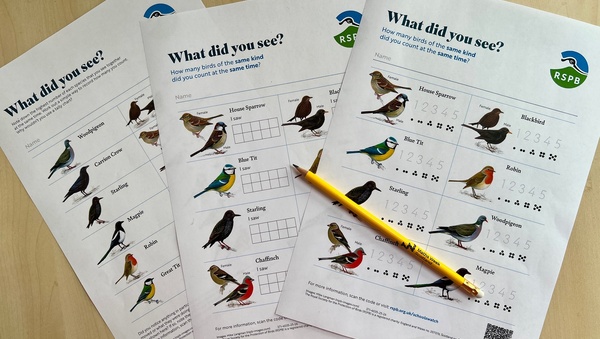
Big Schools' Birdwatch 2026
It is almost time for the RSPB Big Schools’ Bird Watch – the largest citizen science project for schools across the UK. Running from 6th January- 13th February 2026. Sign your school up now, and then get counting in the new year!
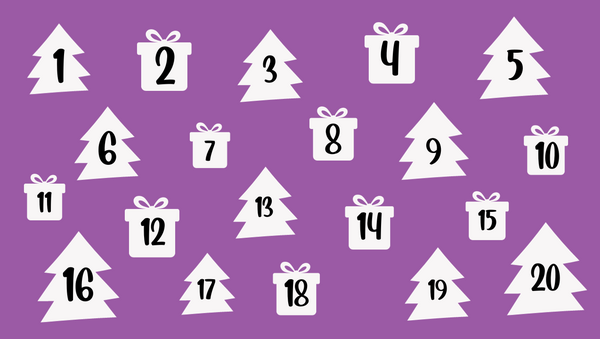
Pick & Mix Your Own Christmas Holiday Countdown
We've pulled together all our seasonal resources from the last three years, and thrown in a few new ones too, so that you can create your own Christmas Holiday Countdown depending on age, ability and preferences. With games, puzzles, art and craft activities to choose from, as well as our interactive puzzle mystery story.
